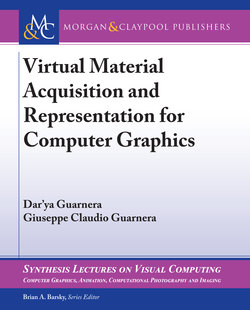Читать книгу Virtual Material Acquisition and Representation for Computer Graphics - Dar'ya Guarnera - Страница 12
На сайте Литреса книга снята с продажи.
ОглавлениеCHAPTER 3
Models of BRDF
In the last 40 years many material models have been proposed and some BRDFs are able to describe a wide subset of a material properties we have mentioned. Generally they can be classified into three big families that have different purposes and different ways of calculating interaction with light:
• Phenomenological
• Physically based
• Data driven
Phenomenological models, also known as Empirical models, are entirely based on reflectance data, which is fitted to analytical formulas, thus approximating the reflectance and reproducing characteristics of real world materials, but they will not necessarily appear realistic unless placed in an accurately simulated environment for such a model.
Physically based models are based on Physics and Optics, with the assumption that the surface is rough at a fine scale, therefore described by a collection of micro facets with some distribution D of size and direction; these models are also referred to as “first principle” models. Usually they are represented by accurate and adjustable formulae; however the most common mathematical model has the form:
which also takes into account the Fresnel term F. Effects like masking and self-shadowing (see Figure 3.1) [AMHH08] depend on the projected area of the microfacets and hence on the distribution D, generally described by the geometrical attenuation term G; for a review of common masking functions and a derivation of the exact form of the masking function from the microsurface profile, see the work by Heitz [Hei14]. This class of models can represent unique properties of the material and may include subsurface structure, generally resulting in complex calculations due to the interaction of the light with the surface structure.
Data-Driven models approximates measured BRDFs with a suitable function space, for example, spherical harmonics or wavelets, weighted sum of separable functions or product of functions. Measured BRDF data, produced by most of the setups described in Chapter 4, can be stored in a table or a grid and then interpolated to produce a large look-up table when data is needed. This method is simple but inefficient in terms of storage. Moreover, the measured raw data is often noisy, hence the noise is likely to appear in the rendered material. A measured BRDF can be fitted to analytic models and employed to reconstruct the BRDF, thus significantly reducing storage size. The downside of this strategy is related to the inflexibility of many models, which are hard to edit and able to represent only limited classes of materials. A different solution is to approximate measured BRDFs with a suitable function space, for example, spherical harmonics or wavelets, weighted sum of separable functions, or product of functions. We refer to this class of models as Data-Driven models, described in Section 3.3.
